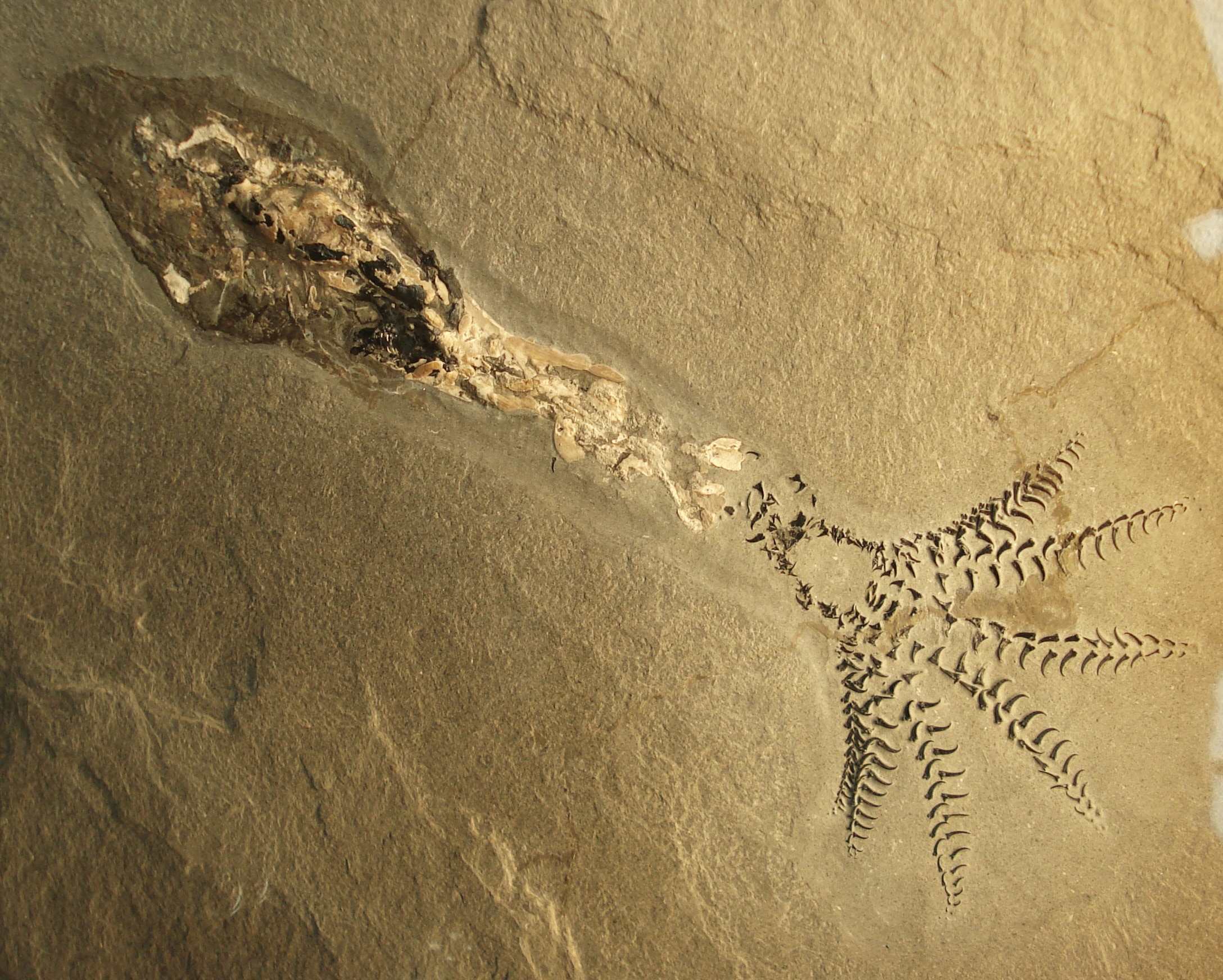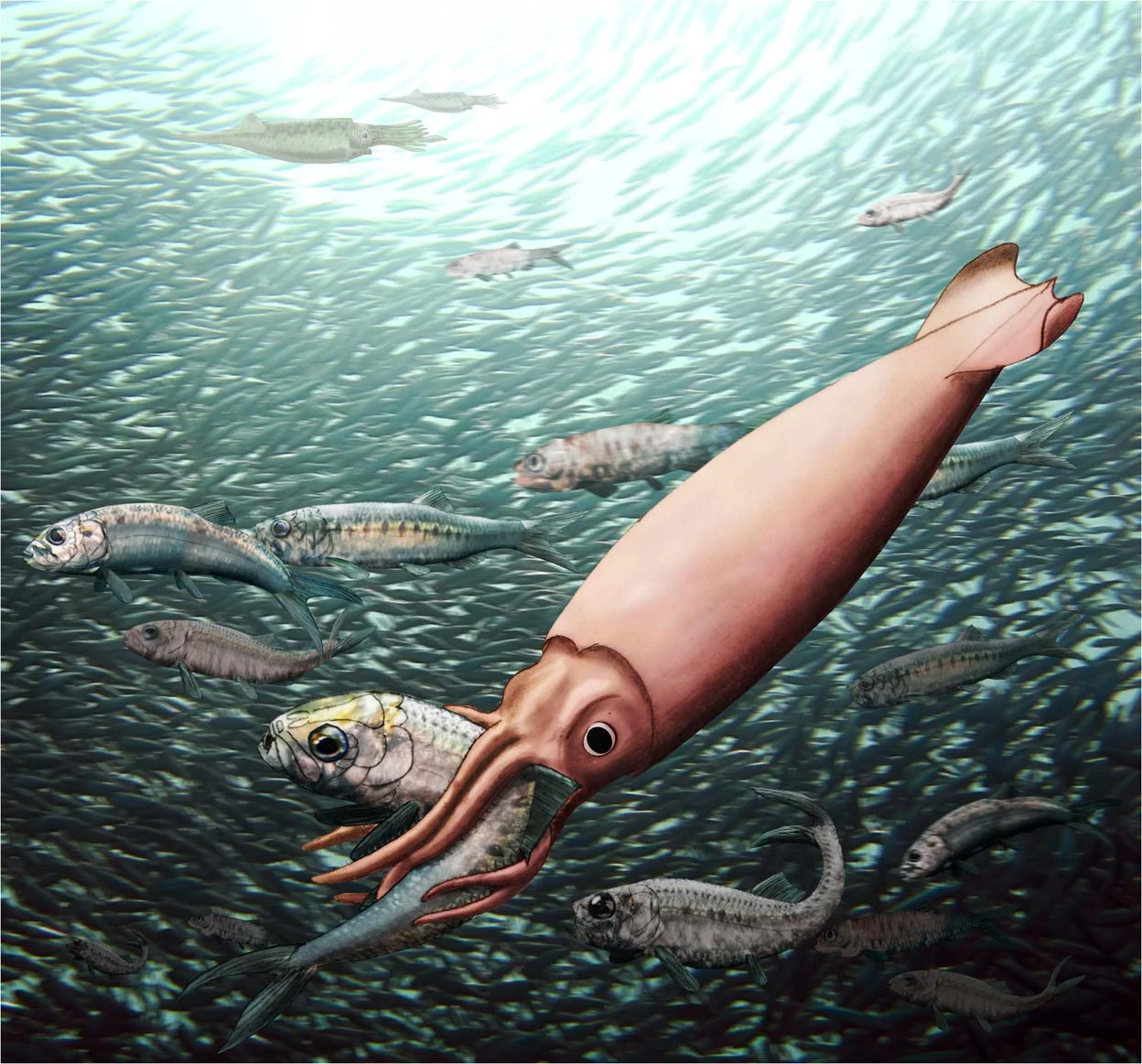Clarkeiteuthis on:
[Wikipedia]
[Google]
[Amazon]
''Clarkeiteuthis'' is a genus of extinct belemnoid
 Two species are described, ''C. conocauda'' is known from
Two species are described, ''C. conocauda'' is known from
 Well-preserved specimens of ''C. conocauda'' with ''Leptolepis bronni'' (invalid species of ''Leptolepis'') in its arms are known from Posidonia Shale. Preservation of fossil and behavior of living cephalopod suggests that ''Clarkeiteuthis'' probably contracted its arms to pull prey towards its mouth to cut the spine by using its
Well-preserved specimens of ''C. conocauda'' with ''Leptolepis bronni'' (invalid species of ''Leptolepis'') in its arms are known from Posidonia Shale. Preservation of fossil and behavior of living cephalopod suggests that ''Clarkeiteuthis'' probably contracted its arms to pull prey towards its mouth to cut the spine by using its
cephalopod
A cephalopod is any member of the molluscan class Cephalopoda ( Greek plural , ; "head-feet") such as a squid, octopus, cuttlefish, or nautilus. These exclusively marine animals are characterized by bilateral body symmetry, a prominent head, ...
known from the lower Jurassic
The Jurassic ( ) is a Geological period, geologic period and System (stratigraphy), stratigraphic system that spanned from the end of the Triassic Period million years ago (Mya) to the beginning of the Cretaceous Period, approximately Mya. The J ...
in Germany
Germany, officially the Federal Republic of Germany (FRG),, is a country in Central Europe. It is the most populous member state of the European Union. Germany lies between the Baltic and North Sea to the north and the Alps to the sou ...
and England
England is a country that is part of the United Kingdom. It shares land borders with Wales to its west and Scotland to its north. The Irish Sea lies northwest and the Celtic Sea to the southwest. It is separated from continental Europe ...
. Described two species, ''C. conocauda'' and ''C. montefiorei'' are originally described as species of phragmoteuthid ''Phragmoteuthis
''Phragmoteuthis'' is a genus of extinct coleoid cephalopod known from the late Triassic to the lower Jurassic. Its soft tissue has been preserved; some specimens contain intact ink sac
An ink sac is an anatomical feature that is found in man ...
'', but got their own genus and moved to Diplobelida.
Description
Posidonia Shale
The Posidonia Shale (german: Posidonienschiefer, also called Schistes Bitumineux in Luxembourg) geologically known as the Sachrang Formation, is an Early Jurassic (Toarcian) geological formation of southwestern and northeast Germany, northern Swi ...
, and ''C. montefiorei'' is known from Charmouth Mudstone Formation
The Charmouth Mudstone Formation is a geological formation in England. It preserves fossils dating back to the early part of the Jurassic period (Sinemurian–Pliensbachian). It forms part of the lower Lias Group. It is most prominently exposed a ...
.
''Clarkeiteuthis'' had long phragmocone and ten short, hook-bearing arms
Arms or ARMS may refer to:
*Arm or arms, the upper limbs of the body
Arm, Arms, or ARMS may also refer to:
People
* Ida A. T. Arms (1856–1931), American missionary-educator, temperance leader
Coat of arms or weapons
*Armaments or weapons
**Fi ...
. Although it is originally considered as phragmoteuthid, this classification has been discussed by modern researchers, as it lacked a broad three-lobed proostracum (The anterior prolongation of the guard of the phragmocone), the autapomorphy
In phylogenetics, an autapomorphy is a distinctive feature, known as a derived trait, that is unique to a given taxon. That is, it is found only in one taxon, but not found in any others or outgroup taxa, not even those most closely related to t ...
of phragmoteuthid.
''C. conocauda'' had total length about . This species is well preserved, soft tissues such as mantle and ink sac
An ink sac is an anatomical feature that is found in many cephalopod mollusks used to produce the defensive cephalopod ink. With the exception of nocturnal and very deep water cephalopods, all Coleoidea (squid, octopus and cuttlefish) which dwell ...
are visible. One arm had around 30 hooks.
Palaeobiology
 Well-preserved specimens of ''C. conocauda'' with ''Leptolepis bronni'' (invalid species of ''Leptolepis'') in its arms are known from Posidonia Shale. Preservation of fossil and behavior of living cephalopod suggests that ''Clarkeiteuthis'' probably contracted its arms to pull prey towards its mouth to cut the spine by using its
Well-preserved specimens of ''C. conocauda'' with ''Leptolepis bronni'' (invalid species of ''Leptolepis'') in its arms are known from Posidonia Shale. Preservation of fossil and behavior of living cephalopod suggests that ''Clarkeiteuthis'' probably contracted its arms to pull prey towards its mouth to cut the spine by using its beaks
The beak, bill, or rostrum is an external anatomical structure found mostly in birds, but also in turtles, non-avian dinosaurs and a few mammals. A beak is used for eating, preening, manipulating objects, killing prey, fighting, probing for food, ...
, and then feed on it. In all the three specimens of ''C. conocauda'' with catching preys had ''Leptolepis'' in its arms. ''Leptolepis'' is most common fish in the formation, and it lacked thick scales, so it was probably the most common prey of ''Clarkeiteuthis''.
Unlike belemnites which are considered as good swimmers, diplobelids like ''Clarkeiteuthis'' were probably less active swimmers, with the capability of occasional short bursts of rapid swimming movements.
References
{{Taxonbar, from=Q111869595 Belemnoidea Jurassic cephalopods Mesozoic cephalopods of Europe Prehistoric life of Europe Early Jurassic first appearances Prehistoric cephalopod genera